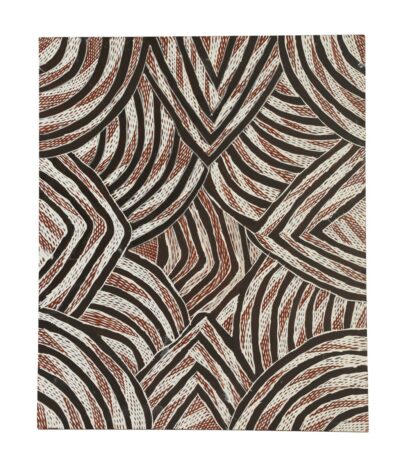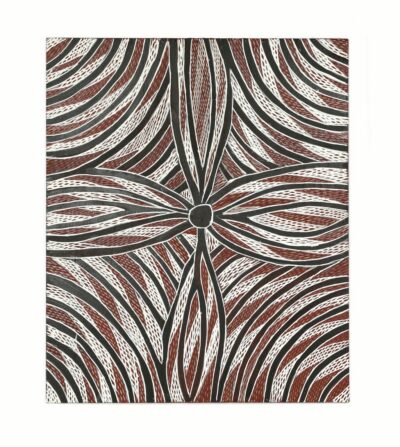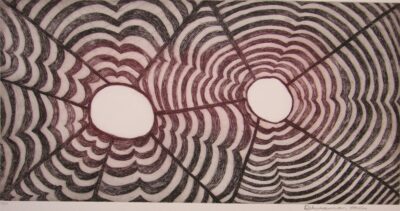dhuwarrwarr-marika
Homeland: Yirrkala / Yalaŋbara / Gulurunga / Bremer Island
Clan: Rirratjiŋu, Miliwurrwurr group
Moiety: Dhuwa
Dhuwarrwarr is sister of Wandjuk, Bayŋgul and Banduk Marika, and daughter of Mawalan, the Rirratjiŋu clan leader who originally welcomed the missionaries to set up on his land, creating the beginnings of modern day Yirrkala. Dhuwarrwarr is believed by many (including Professor Howard Morphy and herself) to be the first Yolŋu woman authorised to paint sacred designs on her own. This is supported by some recently rediscovered contemporaneous evidence. The 1974 catalogue for ‘Art of Aboriginal Australians presented by Rothmans Pall Mall Canada’ says the following about a work by Dhuwarrwarr, “This is a most unusual painting in that it was painted by a woman of the Rirratjingu tribe of Yirrkala. It is unprecedented for a woman to be allowed to paint on bark any aspect of sacred mythology. Dhuwarrwarr’s father, Mawalan, was the ceremonial leader of the Rirratjingu tribe and was steeped in the mythology of his people. He painted up to the time of his death, and with failing eyesight and poor health, allowed Dhuwarrwarr to help him, after consultation with his sons and brothers and elders of the group. She has not painted since his death until recently, when she again requested permission from her brothers to do so.”
Dhuwarrwarr continues;
“From that time when my father was painting my elder sister helped him but she is a little blind now. From when I was twelve to this time I started to paint. Sometimes I used to help my father. That one (her nephew Mawalan #2) he learned from grandfather and his father. He watched his grandfather – that my father. Currently I’m doing my own art using the same design and lino printing – my fathers design but my own imagination.
When my father was alive they only painted on bark. He used to cut bark and lay it flat and store it for the dry season. His (Mawalan #2) sister Rarriwuy is learning – I have been teaching her. I’m teaching my brother’s children for all the painting as well as my children. I used to ask them to come and watch me. I use my own colours from the shore – the yellow and the red, just a rock, and the black, bäyŋu (not) charcoal. Like my brother (Wandjuk), I sometimes mix yellow and black to make green. I used to go and get it in a bucket and mash it up and leave it in the sun to dry.
I am trying hard to get this man (Mawalan#2) to come back to do the painting. Not all the painting I can remember (being done) but this one; Djaŋ’kawu and this one from my brother, and this one; Djarrak (seagull). Early stage when Dorothy Bennett used to come here to collect barks my father and brother used to paint.”
Dhuwarrwarr is a statesperson for her people, representing them on various committees and institutions such as Land Councils and Women’s groups. In 1993 she travelled to Europe as an invited speaking guest for the opening of the international traveling exhibition of ‘Aratjara – Art of the First Australians’ . She also attends to the day-to-day needs of a wide group of young and old clans-people with a particular emphasis on guiding and guarding the young minds of her family. She lives on Rirratjingu land either at her house overlooking the beach and creek at Yirrkala or at Gutjangan on Bremer Island. Her first genuine solo exhibition held relatively late in her career, ‘Milngurr’ at Vivien Anderson Gallery in Melbourne in 2008 was a literal sell out within 5 minutes of opening. Institutional collections purchased the bulk of the works.
She has continued to exhibit commercially and to be shown in Institutional shows to this day. She creates every day as a personal need.


